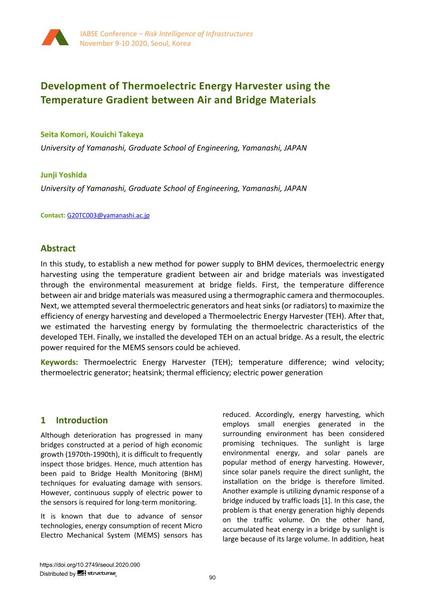Development of Thermoelectric Energy Harvester using the Temperature Gradient between Air and Bridge Materials

|
|
|||||||||||
Détails bibliographiques
| Auteur(s): |
Seita Komori
(University of Yamanashi, Graduate School of Engineering, Yamanashi, JAPAN)
Kouichi Takeya (University of Yamanashi, Graduate School of Engineering, Yamanashi, JAPAN) Junji Yoshida (University of Yamanashi, Graduate School of Engineering, Yamanashi, JAPAN) |
||||
|---|---|---|---|---|---|
| Médium: | papier de conférence | ||||
| Langue(s): | anglais | ||||
| Conférence: | IABSE Conference: Risk Intelligence of Infrastructures, Seoul, South Korea, 9-10 November 2020 | ||||
| Publié dans: | IABSE Conference Seoul 2020 | ||||
|
|||||
| Page(s): | 90-97 | ||||
| Nombre total de pages (du PDF): | 8 | ||||
| DOI: | 10.2749/seoul.2020.090 | ||||
| Abstrait: |
In this study, to establish a new method for power supply to BHM devices, thermoelectric energy harvesting using the temperature gradient between air and bridge materials was investigated through the environmental measurement at bridge fields. First, the temperature difference between air and bridge materials was measured using a thermographic camera and thermocouples. Next, we attempted several thermoelectric generators and heat sinks (or radiators) to maximize the efficiency of energy harvesting and developed a Thermoelectric Energy Harvester (TEH). After that, we estimated the harvesting energy by formulating the thermoelectric characteristics of the developed TEH. Finally, we installed the developed TEH on an actual bridge. As a result, the electric power required for the MEMS sensors could be achieved. |
||||
